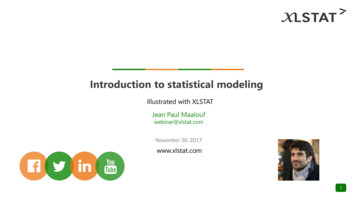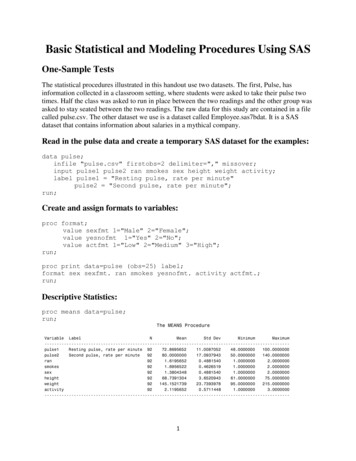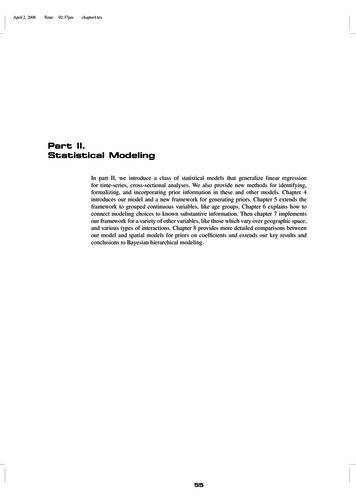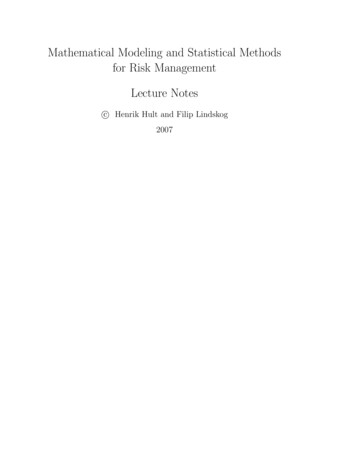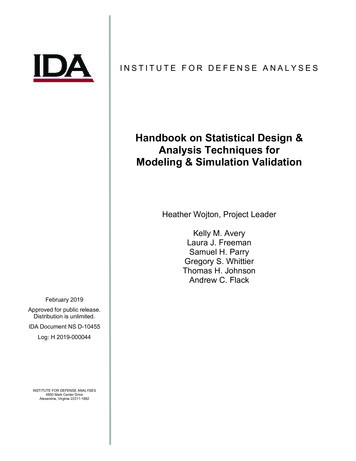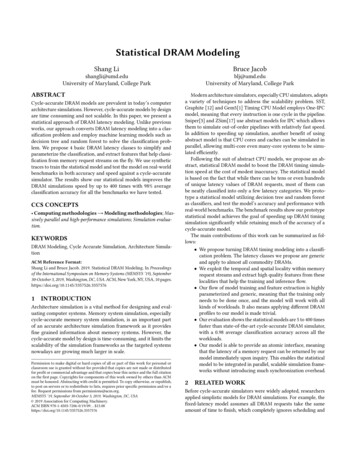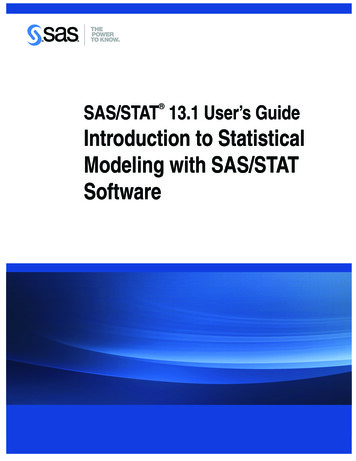
Transcription
SAS/STAT 13.1 User’s GuideIntroduction to StatisticalModeling with SAS/STATSoftware
This document is an individual chapter from SAS/STAT 13.1 User’s Guide.The correct bibliographic citation for the complete manual is as follows: SAS Institute Inc. 2013. SAS/STAT 13.1 User’s Guide.Cary, NC: SAS Institute Inc.Copyright 2013, SAS Institute Inc., Cary, NC, USAAll rights reserved. Produced in the United States of America.For a hard-copy book: No part of this publication may be reproduced, stored in a retrieval system, or transmitted, in any form or byany means, electronic, mechanical, photocopying, or otherwise, without the prior written permission of the publisher, SAS InstituteInc.For a web download or e-book: Your use of this publication shall be governed by the terms established by the vendor at the timeyou acquire this publication.The scanning, uploading, and distribution of this book via the Internet or any other means without the permission of the publisher isillegal and punishable by law. Please purchase only authorized electronic editions and do not participate in or encourage electronicpiracy of copyrighted materials. Your support of others’ rights is appreciated.U.S. Government License Rights; Restricted Rights: The Software and its documentation is commercial computer softwaredeveloped at private expense and is provided with RESTRICTED RIGHTS to the United States Government. Use, duplication ordisclosure of the Software by the United States Government is subject to the license terms of this Agreement pursuant to, asapplicable, FAR 12.212, DFAR 227.7202-1(a), DFAR 227.7202-3(a) and DFAR 227.7202-4 and, to the extent required under U.S.federal law, the minimum restricted rights as set out in FAR 52.227-19 (DEC 2007). If FAR 52.227-19 is applicable, this provisionserves as notice under clause (c) thereof and no other notice is required to be affixed to the Software or documentation. TheGovernment’s rights in Software and documentation shall be only those set forth in this Agreement.SAS Institute Inc., SAS Campus Drive, Cary, North Carolina 27513-2414.December 2013SAS provides a complete selection of books and electronic products to help customers use SAS software to its fullest potential. Formore information about our offerings, visit support.sas.com/bookstore or call 1-800-727-3228.SAS and all other SAS Institute Inc. product or service names are registered trademarks or trademarks of SAS Institute Inc. in theUSA and other countries. indicates USA registration.Other brand and product names are trademarks of their respective companies.
Gain Greater Insight into YourSAS Software with SAS Books. Discover all that you need on your journey to knowledge and empowerment.support.sas.com/bookstorefor additional books and resources.SAS and all other SAS Institute Inc. product or service names are registered trademarks or trademarks of SAS Institute Inc. in the USA and other countries. indicates USA registration. Other brand and product names aretrademarks of their respective companies. 2013 SAS Institute Inc. All rights reserved. S107969US.0613
Chapter 3Introduction to Statistical Modeling withSAS/STAT SoftwareContentsOverview: Statistical Modeling . . . . . . . . . . . . . . . . . . . . . . . . . . . . . . . . .24Statistical Models . . . . . . . . . . . . . . . . . . . . . . . . . . . . . . . . . . . .24Classes of Statistical Models . . . . . . . . . . . . . . . . . . . . . . . . . . . . . . .27Linear and Nonlinear Models . . . . . . . . . . . . . . . . . . . . . . . . . .27Regression Models and Models with Classification Effects . . . . . . . . . .28Univariate and Multivariate Models . . . . . . . . . . . . . . . . . . . . . .30Fixed, Random, and Mixed Models . . . . . . . . . . . . . . . . . . . . . .31Generalized Linear Models . . . . . . . . . . . . . . . . . . . . . . . . . . .33Latent Variable Models . . . . . . . . . . . . . . . . . . . . . . . . . . . . .33Bayesian Models . . . . . . . . . . . . . . . . . . . . . . . . . . . . . . . .36Classical Estimation Principles . . . . . . . . . . . . . . . . . . . . . . . . . . . . .37Least Squares . . . . . . . . . . . . . . . . . . . . . . . . . . . . . . . . . .37Likelihood . . . . . . . . . . . . . . . . . . . . . . . . . . . . . . . . . . .39Inference Principles for Survey Data . . . . . . . . . . . . . . . . . . . . . .42Statistical Background . . . . . . . . . . . . . . . . . . . . . . . . . . . . . . . . . . . . .43Hypothesis Testing and Power . . . . . . . . . . . . . . . . . . . . . . . . . . . . . .43Important Linear Algebra Concepts . . . . . . . . . . . . . . . . . . . . . . . . . . .44Expectations of Random Variables and Vectors . . . . . . . . . . . . . . . . . . . . .51Mean Squared Error . . . . . . . . . . . . . . . . . . . . . . . . . . . . . . . . . . .Linear Model Theory . . . . . . . . . . . . . . . . . . . . . . . . . . . . . . . . . .5355Finding the Least Squares Estimators . . . . . . . . . . . . . . . . . . . . .55Analysis of Variance . . . . . . . . . . . . . . . . . . . . . . . . . . . . . .57Estimating the Error Variance . . . . . . . . . . . . . . . . . . . . . . . . .58Maximum Likelihood Estimation . . . . . . . . . . . . . . . . . . . . . . .58Estimable Functions . . . . . . . . . . . . . . . . . . . . . . . . . . . . . .59Test of Hypotheses . . . . . . . . . . . . . . . . . . . . . . . . . . . . . . .59Residual Analysis . . . . . . . . . . . . . . . . . . . . . . . . . . . . . . . .62Sweep Operator . . . . . . . . . . . . . . . . . . . . . . . . . . . . . . . . .64References . . . . . . . . . . . . . . . . . . . . . . . . . . . . . . . . . . . . . . . . . . .65
24 F Chapter 3: Introduction to Statistical Modeling with SAS/STAT SoftwareOverview: Statistical ModelingThere are more than 70 procedures in SAS/STAT software, and the majority of them are dedicated to solvingproblems in statistical modeling. The goal of this chapter is to provide a roadmap to statistical models and tomodeling tasks, enabling you to make informed choices about the appropriate modeling context and tool. Thischapter also introduces important terminology, notation, and concepts used throughout this documentation.Subsequent introductory chapters discuss model families and related procedures.It is difficult to capture the complexity of statistical models in a simple scheme, so the classification usedhere is necessarily incomplete. It is most practical to classify models in terms of simple criteria, such as thepresence of random effects, the presence of nonlinearity, characteristics of the data, and so on. That is theapproach used here. After a brief introduction to statistical modeling in general terms, the chapter describes anumber of model classifications and relates them to modeling tools in SAS/STAT software.Statistical ModelsDeterministic and Stochastic ModelsPurely mathematical models, in which the relationships between inputs and outputs are captured entirelyin deterministic fashion, can be important theoretical tools but are impractical for describing observational,experimental, or survey data. For such phenomena, researchers usually allow the model to draw on stochasticas well as deterministic elements. When the uncertainty of realizations leads to the inclusion of randomcomponents, the resulting models are called stochastic models. A statistical model, finally, is a stochasticmodel that contains parameters, which are unknown constants that need to be estimated based on assumptionsabout the model and the observed data.There are many reasons why statistical models are preferred over deterministic models. For example: Randomness is often introduced into a system in order to achieve a certain balance or representativeness.For example, random assignment of treatments to experimental units allows unbiased inferences abouttreatment effects. As another example, selecting individuals for a survey sample by random mechanismsensures a representative sample. Even if a deterministic model can be formulated for the phenomenon under study, a stochastic modelcan provide a more parsimonious and more easily comprehended description. For example, it ispossible in principle to capture the result of a coin toss with a deterministic model, taking into accountthe properties of the coin, the method of tossing, conditions of the medium through which the cointravels and of the surface on which it lands, and so on. A very complex model is required to describethe simple outcome—heads or tails. Alternatively, you can describe the outcome quite simply as theresult of a stochastic process, a Bernoulli variable that results in heads with a certain probability. It is often sufficient to describe the average behavior of a process, rather than each particular realization.For example, a regression model might be developed to relate plant growth to nutrient availability.The explicit aim of the model might be to describe how the average growth changes with nutrientavailability, not to predict the growth of an individual plant. The support for the notion of averaging ina model lies in the nature of expected values, describing typical behavior in the presence of randomness.This, in turn, requires that the model contain stochastic components.
Statistical Models F 25The defining characteristic of statistical models is their dependence on parameters and the incorporation ofstochastic terms. The properties of the model and the properties of quantities derived from it must be studiedin a long-run, average sense through expectations, variances, and covariances. The fact that the parameters ofthe model must be estimated from the data introduces a stochastic element in applying a statistical model:because the model is not deterministic but includes randomness, parameters and related quantities derivedfrom the model are likewise random. The properties of parameter estimators can often be described onlyin an asymptotic sense, imagining that some aspect of the data increases without bound (for example, thenumber of observations or the number of groups).The process of estimating the parameters in a statistical model based on your data is called fitting the model.For many classes of statistical models there are a number of procedures in SAS/STAT software that canperform the fitting. In many cases, different procedures solve identical estimation problems—that is, theirparameter estimates are identical. In some cases, the same model parameters are estimated by differentstatistical principles, such as least squares versus maximum likelihood estimation. Parameter estimatesobtained by different methods typically have different statistical properties—distribution, variance, bias, andso on. The choice between competing estimation principles is often made on the basis of properties of theestimators. Distinguishing properties might include (but are not necessarily limited to) computational ease,interpretive ease, bias, variance, mean squared error, and consistency.Model-Based and Design-Based RandomnessA statistical model is a description of the data-generating mechanism, not a description of the specific data towhich it is applied. The aim of a model is to capture those aspects of a phenomenon that are relevant to inquiryand to explain how the data could have come about as a realization of a random experiment. These relevantaspects might include the genesis of the randomness and the stochastic effects in the phenomenon understudy. Different schools of thought can lead to different model formulations, different analytic strategies,and different results. Coarsely, you can distinguish between a viewpoint of innate randomness and one ofinduced randomness. This distinction leads to model-based and design-based inference approaches.In a design-based inference framework, the random variation in the observed data is induced by randomselection or random assignment. Consider the case of a survey sample from a finite population of sizeN; suppose that FN D fyi W i 2 UN g denotes the finite set of possible values and UN is the index setUN D f1; 2; : : : ; N g. Then a sample S, a subset of UN , is selected by probability rules. The realizationof the random experiment is the selection of a particular set S; the associated values selected from FN areconsidered fixed. If properties of a design-based sampling estimator are evaluated, such as bias, variance, andmean squared error, they are evaluated with respect to the distribution induced by the sampling mechanism.Design-based approaches also play an important role in the analysis of data from controlled experiments byrandomization tests. Suppose that k treatments are to be assigned to kr homogeneous experimental units. Ifyou form k sets of r units with equal probability, and you assign the jth treatment to the tth set, a completelyrandomized experimental design (CRD) results. A design-based view treats the potential response of aparticular treatment for a particular experimental unit as a constant. The stochastic nature of the error-controldesign is induced by randomly selecting one of the potential responses.Statistical models are often used in the design-based framework. In a survey sample the model is used tomotivate the choice of the finite population parameters and their sample-based estimators. In an experimentaldesign, an assumption of additivity of the contributions from treatments, experimental units, observationalerrors, and experimental errors leads to a linear statistical model. The approach to statistical inferencewhere statistical models are used to construct estimators and their properties are evaluated with respect to
26 F Chapter 3: Introduction to Statistical Modeling with SAS/STAT Softwarethe distribution induced by the sample selection mechanism is known as model-assisted inference (Särndal,Swensson, and Wretman 1992).In a purely model-based framework, the only source of random variation for inference comes from the unknown variation in the responses. Finite population values are thought of as a realization of a superpopulationmodel that describes random variables Y1 ; Y2 ; . The observed values y1 ; y2 ; are realizations of theserandom variables. A model-based framework does not imply that there is only one source of random variationin the data. For example, mixed models might contain random terms that represent selection of effects fromhierarchical (super-) populations at different granularity. The analysis takes into account the hierarchicalstructure of the random variation, but it continues to be model based.A design-based approach is implicit in SAS/STAT procedures whose name commences with SURVEY, suchas the SURVEYFREQ, SURVEYMEANS, SURVEYREG, SURVEYLOGISTIC, and SURVEYPHREGprocedures. Inferential approaches are model based in other SAS/STAT procedures. For more informationabout analyzing survey data with SAS/STAT software, see Chapter 14, “Introduction to Survey Procedures.”Model SpecificationIf the model is accepted as a description of the data-generating mechanism, then its parameters are estimatedusing the data at hand. Once the parameter estimates are available, you can apply the model to answerquestions of interest about the study population. In other words, the model becomes the lens through whichyou view the problem itself, in order to ask and answer questions of interest. For example, you might use theestimated model to derive new predictions or forecasts, to test hypotheses, to derive confidence intervals, andso on.Obviously, the model must be “correct” to the extent that it sufficiently describes the data-generatingmechanism. Model selection, diagnosis, and discrimination are important steps in the model-building process.This is typically an iterative process, starting with an initial model and refining it. The first important stepis thus to formulate your knowledge about the data-generating process and to express the real observedphenomenon in terms of a statistical model. A statistical model describes the distributional properties of oneor more variables, the response variables. The extent of the required distributional specification depends onthe model, estimation technique, and inferential goals. This description often takes the simple form of amodel with additive error structure:response mean errorIn mathematical notation this simple model equation becomesY D f .x1 ; ; xk I ˇ1 ; ; ˇp / C In this equation Y is the response variable, often also called the dependent variable or the outcome variable.The terms x1 ; ; xk denote the values of k regressor variables, often termed the covariates or the “independent” variables. The terms ˇ1 ; ; ˇp denote parameters of the model, unknown constants that are to beestimated. The term denotes the random disturbance of the model; it is also called the residual term or theerror term of the model.In this simple model formulation, stochastic properties are usually associated only with the term. Thecovariates x1 ; ; xk are usually known values, not subject to random variation. Even if the covariates aremeasured with error, so that their values are in principle random, they are considered fixed in most models fitby SAS/STAT software. In other words, stochastic properties under the model are derived conditional on the
Classes of Statistical Models F 27xs. If is the only stochastic term in the model, and if the errors have a mean of zero, then the function f . /is the mean function of the statistical model. More formally,EŒY D f .x1 ; ; xk I ˇ1 ; ; ˇp /where EŒ denotes the expectation operator.In many applications, a simple model formulation is inadequate. It might be necessary to specify not only thestochastic properties of a single error term, but also how model errors associated with different observationsrelate to each other. A simple additive error model is typically inappropriate to describe the data-generatingmechanism if the errors do not have zero mean or if the variance of observations depends on their means.For example, if Y is a Bernoulli random variable that takes on the values 0 and 1 only, a regression modelwith additive error is not meaningful. Models for such data require more elaborate formulations involvingprobability distributions.Classes of Statistical ModelsLinear and Nonlinear ModelsA statistical estimation problem is nonlinear if the estimating equations—the equations whose solutionyields the parameter estimates—depend on the parameters in a nonlinear fashion. Such estimation problemstypically have no closed-form solution and must be solved by iterative, numerical techniques.Nonlinearity in the mean function is often used to distinguish between linear and nonlinear models. A modelhas a nonlinear mean function if the derivative of the mean function with respect to the parameters dependson at least one other parameter. Consider, for example, the following models that relate a response variable Yto a single regressor variable x:EŒY jx D ˇ0 C ˇ1 xEŒY jx D ˇ0 C ˇ1 x C ˇ2 x 2EŒY jx D ˇ C x In these expressions, EŒY jx denotes the expected value of the response variable Y at the fixed value ofx. (The conditioning on x simply indicates that the predictor variables are assumed to be non-random.Conditioning is often omitted for brevity in this and subsequent chapters.)The first model in the previous list is a simple linear regression (SLR) model. It is linear in the parameters ˇ0and ˇ1 since the model derivatives do not depend on unknowns:@.ˇ0 C ˇ1 x/ D 1ˇ0@.ˇ0 C ˇ1 x/ D xˇ1
28 F Chapter 3: Introduction to Statistical Modeling with SAS/STAT SoftwareThe model is also linear in its relationship with x (a straight line). The second model is also linear in theparameters, since @ˇ0 C ˇ1 x C ˇ2 x 2 D 1ˇ0 @ˇ0 C ˇ1 x C ˇ2 x 2 D xˇ1 @ˇ0 C ˇ1 x C ˇ2 x 2 D x 2ˇ2However, this second model is curvilinear, since it exhibits a curved relationship when plotted against x. Thethird model, finally, is a nonlinear model since@.ˇ C x / D 1ˇ@x.ˇ C x / D 2The second of these derivatives depends on a parameter . A model is nonlinear if it is not linear in at leastone parameter. Only the third model is a nonlinear model. A graph of EŒY versus the regressor variable thusdoes not indicate whether a model is nonlinear. A curvilinear relationship in this graph can be achieved by amodel that is linear in the parameters.Nonlinear mean functions lead to nonlinear estimation. It is important to note, however, that nonlinearestimation arises also because of the estimation principle or because the model structure contains nonlinearityin other parts, such as the covariance structure. For example, fitting a simple linear regression model byminimizing the sum of the absolute residuals leads to a nonlinear estimation problem despite the fact that themean function is linear.Regression Models and Models with Classification EffectsA linear regression model in the broad sense has the formY D Xˇ C where Y is the vector of response values, X is the matrix of regressor effects, ˇ is the vector of regressionparameters, and is the vector of errors or residuals. A regression model in the narrow sense—as comparedto a classification model—is a linear model in which all regressor effects are continuous variables. In otherwords, each effect in the model contributes a single column to the X matrix and a single parameter to theoverall model. For example, a regression of subjects’ weight (Y) on the regressors age (x1 ) and body massindex (bmi, x2 ) is a regression model in this narrow sense. In symbolic notation you can write this regressionmodel asweight age bmi errorThis symbolic notation expands into the statistical modelYi D ˇ0 C ˇ1 xi1 C ˇ2 xi 2 C i
Classes of Statistical Models F 29Single parameters are used to model the effects of age .ˇ1 / and bmi .ˇ2 /, respectively.A classification effect, on the other hand, is associated with possibly more than one column of the X matrix.Classification with respect to a variable is the process by which each observation is associated with one of klevels; the process of determining these k levels is referred to as levelization of the variable. Classificationvariables are used in models to identify experimental conditions, group membership, treatments, and soon. The actual values of the classification variable are not important, and the variable can be a numeric ora character variable. What is important is the association of discrete values or levels of the classificationvariable with groups of observations. For example, in the previous illustration, if the regression also takes intoaccount the subjects’ gender, this can be incorporated in the model with a two-level classification variable.Suppose that the values of the gender variable are coded as ‘F’ and ‘M’, respectively. In symbolic notationthe modelweight age bmi gender errorexpands into the statistical modelYi D ˇ0 C ˇ1 xi1 C ˇ2 xi 2 C 1 I.gender D 0 F0 / C 2 I.gender D 0 M0 / C iwhere I(gender ‘F’) is the indicator function that returns 1 if the value of the gender variable is ‘F’ and0 otherwise. Parameters 1 and 2 are associated with the gender classification effect. This form ofparameterizing the gender effect in the model is only one of several different methods of incorporatingthe levels of a classification variable in the model. This form, the so-called singular parameterization, isthe most general approach, and it is used in the GLM, MIXED, and GLIMMIX procedures. Alternatively,classification effects with various forms of nonsingular parameterizations are available in such proceduresas GENMOD and LOGISTIC. See the documentation for the individual SAS/STAT procedures on theirrespective facilities for parameterizing classification variables and the section “Parameterization of ModelEffects” on page 387 in Chapter 19, “Shared Concepts and Topics,” for general details.Models that contain only classification effects are often identified with analysis of variance (ANOVA) models,because ANOVA methods are frequently used in their analysis. This is particularly true for experimental datawhere the model effects comprise effects of the treatment and error-control design. However, classificationeffects appear more widely than in models to which analysis of variance methods are applied. For example,many mixed models, where parameters are estimated by restricted maximum likelihood, consist entirely ofclassification effects but do not permit the sum of squares decomposition typical for ANOVA techniques.Many models contain both continuous and classification effects. For example, a continuous-by-classeffect consists of at least one continuous variable and at least one classification variable. Such effects areconvenient, for example, to vary slopes in a regression model by the levels of a classification variable. Also,recent enhancements to linear modeling syntax in some SAS/STAT procedures (including GLIMMIX andGLMSELECT) enable you to construct sets of columns in X matrices from a single continuous variable. Anexample is modeling with splines where the values of a continuous variable x are expanded into a spline basisthat occupies multiple columns in the X matrix. For purposes of the analysis you can treat these columns as asingle unit or as individual, unrelated columns. For more details, see the section “EFFECT Statement” onpage 397 in Chapter 19, “Shared Concepts and Topics.”
30 F Chapter 3: Introduction to Statistical Modeling with SAS/STAT SoftwareUnivariate and Multivariate ModelsA multivariate statistical model is a model in which multiple response variables are modeled jointly. Suppose,for example, that your data consist of heights .hi / and weights .wi / of children, collected over several years.ti /. The following separate regressions represent two univariate models:wi D ˇw0 C ˇw1 ti C wihi D ˇh0 C ˇh1 ti C hiIn the univariate setting, no information about the children’s heights “flows” to the model about their weightsand vice versa. In a multivariate setting, the heights and weights would be modeled jointly. For example: wi wiYi DD Xˇ Chi hiD Xˇ C i 2 1 12 i 0; 12 22The vectors Yi and i collect the responses and errors for the two observation that belong to the same subject.The errors from the same child now have the correlation 12CorrŒ wi ; hi D q 12 22and it is through this correlation that information about heights “flows” to the weights and vice versa. Thissimple example shows only one approach to modeling multivariate data, through the use of covariancestructures. Other techniques involve seemingly unrelated regressions, systems of linear equations, and so on.Multivariate data can be coarsely classified into three types. The response vectors of homogeneous multivariate data consist of observations of the same attribute. Such data are common in repeated measuresexperiments and longitudinal studies, where the same attribute is measured repeatedly over time. Homogeneous multivariate data also arise in spatial statistics where a set of geostatistical data is the incompleteobservation of a single realization of a random experiment that generates a two-dimensional surface. Onehundred measurements of soil electrical conductivity collected in a forest stand compose a single observationof a 100-dimensional homogeneous multivariate vector. Heterogeneous multivariate observations arisewhen the responses that are modeled jointly refer to different attributes, such as in the previous example ofchildren’s weights and heights. There are two important subtypes of heterogeneous multivariate data. Inhomocatanomic multivariate data the observations come from the same distributional family. For example,the weights and heights might both be assumed to be normally distributed. With heterocatanomic multivariate data the observations can come from different distributional families. The following are examples ofheterocatanomic multivariate data: For each patient you observe blood pressure (a continuous outcome), the number of prior episodes ofan illness (a count variable), and whether the patient has a history of diabetes in the family (a binaryoutcome). A multivariate model that models the three attributes jointly might assume a lognormaldistribution for the blood pressure measurements, a Poisson distribution for the count variable and aBernoulli distribution for the family history. In a study of HIV/AIDS survival, you model jointly a patient’s CD4 cell count over time—itself ahomogeneous multivariate outcome—and the survival of the patient (event-time data).
Classes of Statistical Models F 31Fixed, Random, and Mixed ModelsEach term in a statistical model represents either a fixed effect or a random effect. Models in which all effectsare fixed are called fixed-effects models. Similarly, models in which all effects are random—apart frompossibly an overall intercept term—are called random-effects models. Mixed models, then, are those modelsthat have fixed-effects and random-effects terms. In matrix notation, the linear fixed, linear random, andlinear mixed model are represented by the following model equations, respectively:Y D XˇYDC Z C Y D Xˇ C Z C In these expressions, X and Z are design or regressor matrices associated with the fixed and random effects,respectively. The vector ˇ is a vector of fixed-effects parameters, and the vector represents the randomeffects. The mixed modeling procedures in SAS/STAT software assume that the random effects follow anormal distribution with variance-covariance matrix G and, in most cases, that the random effects have meanzero.Random effects are often associated with classification effects, but this is not necessary. As an exampleof random regression effects, you might want to model the slopes in a growth model as consisting of twocomponents: an overall (fixed-effects) slope that represents the slope of the average individual, and individualspecific ra
components, the resulting models are called stochastic models. A statistical model, finally, is a stochastic model that contains parameters, which are unknown constants that need to be estimated based on assumptions about the model and the observed data. There are many reasons why statistical


